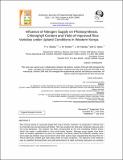| dc.description.abstract | Rice (Oryza sativa) is a principal staple food crop in Kenya. However, its production is still low due to inherently low and declining soil fertility. This has resulted into food and nutritional insecurity and low living standards. The situation has been compounded by the ever escalating fertilizer prices which has made it unaffordable to most small holder farmers. Although some studies have been done on fertilizer application on some rice varieties, the Mwea upland rice (MWUR) varieties were bred under low fertilizer input environment while other authors have indicated that the New Rice for Africa (NERICA) varieties give high yields under low input conditions. The objective of the research was to establish photosynthetic and yield performance of eight promising improved rice varietiesunder four nitrogen (N) levels and identify the variety that gives high yields at relatively low N fertilizer rates. Field experiments were carried out at Alupe in western Kenya under rainfed upland condition. The experiment layout was split plot factorial in a Randomized Complete Block Design with three replicates. The main plot treatments were four rates of nitrogen fertilizer which were; 0 (control), 40, 80 and 120 kg ha-1 applied as urea in two equal splits, sub-plots consisted of four MWUR and four NERICA varieties. The parameters measured included chlorophyll content (SPAD Units), photosynthesis, panicle length, yield at 14% moisture content, filled grain ratio percentage and yield components. The measured parameters increased significantly with increase in the level of nitrogen fertilizer. Varietal difference was significant and MWUR varieties recorded higher chlorophyll content, photosynthetic rates and panicle length and yield component at low nitrogen levels (0 and 40 N) as compared to the NERICAs with MWUR 1 and 2 recording higher values. The NERICAs out-yielded the MWUR varieties at higher nitrogen levels. NERICA 4 recorded highest yield among the NERICA varieties regardless of the N level. Results from our study suggested that MWUR 1 and 2 and NERICA 4 were more tolerant to low nitrogen soil as compared to MWUR 3 and 4 and NERICA 1, 10 and 11, because of higher chlorophyll content, higher photosynthetic rate, higher panicle length, higher filled grain ratio percentage and higher yield component and may be suitable for soils deficient in nitrogen. | en_US |

